Table of Contents

Crab health benefits are numerous which makes it among the few types of food that are delicious to the taste while still being good for the health.
Marine species in general and specifically crab meat is very popular in Southeast Asian cuisine.
Asians count on the crab to ensure they supply their bodies with the daily needs of essential micro-nutrients.
In fact, crab health benefits include the ability to improve bone health, lower the risk of Alzheimer’s, improve vision, etc. …
In this article, based on scientific studies we gathered all the information you need to learn about crab health benefits and side effects, alongside the different uses of this seafood delicacy with some easy-to-make recipes and buying + storing tips.
Crab health benefits:
Crab nutritional data:
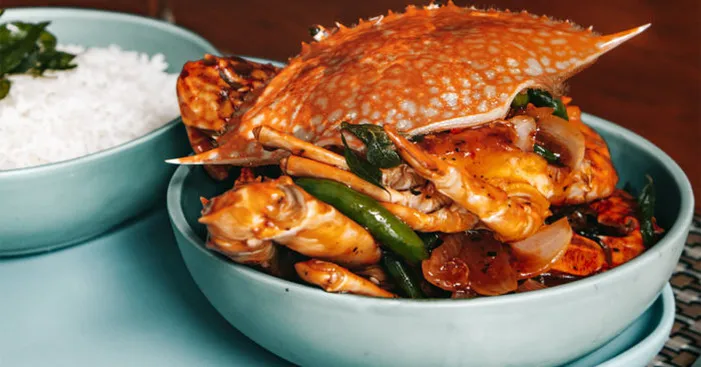
In the US, the most consumed crab is the Dungeness crab and all the data in this article correspond to this type of crab. (1)
According to nutritionists, people need to consume 2 to 3 servings of seafood per week.
It should be noted that one serving of Dungeness crab per person is about 6 ounces (163g).
This amount is almost equal to one crab per person, and it includes 75 mg of calcium and 73mg of magnesium and 300mg phosphorus.
These amounts account for 122%, 18%, and 42% respectively of the daily need for copper, magnesium, and phosphorus.
In addition to a few other traces of minerals, crab also offers a good amount of vitamins such as A, D, E, B1, and B12.
The meat of crab offers 28g of protein per serving (56%) which plays a key role in many body functions.
These are the nutritional data of a serving of Dungeness crab (6oz, 163g) according to the USDA: (2)
- Calories: 140
- Fat: 1.6g
- Protein: 28g
- Sodium: 0.48g (60%)
- Cholesterol: 96mg
- C vitamin: 6%
- B6 vitamin: 19%
- B12 vitamin: 610%
- Calcium: 6%
- Iron : 3%
- Magnesium: 18%
- Phosphorus: 42%
- Potassium : 12%
- Zinc: 63%
- Selenium : 110%
- Copper: 120%
Crab benefits:
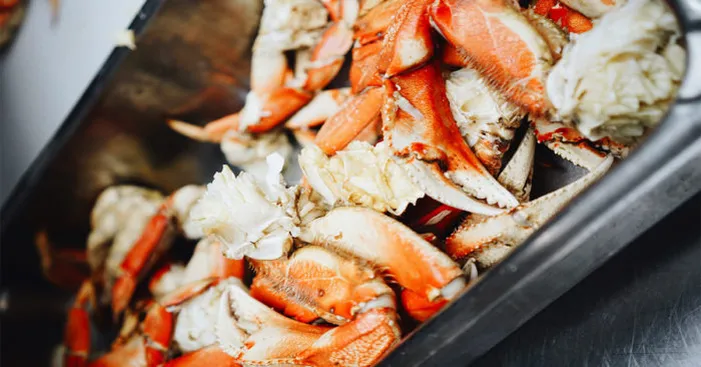
Help lose weight:
With just 1.8g of fat per serving, crab is among the leanest types of meat and certainly healthier than beef or pork. (3)
In fact, just for the sake of comparison for the same amount of 6 ounces (165g) beef offers 330 calories and 15g of fat.
On the other hand, crab only offers 160 calories per 1 crab which makes it a great protein source for those who want to follow a low-calorie diet.
Reduce the risk of cardiovascular diseases:
The best thing about most seafood is that they contain essential fatty acids with almost no saturated fats.
This is very beneficial as scientists proved that polyunsaturated fats may lower the bad cholesterol in the body and promote better cardiovascular health. (4)
In the same sense, even that tiny amount of fat in crab is mainly omega 3 and omega 9 fatty acids which lower bad cholesterol in the blood.
By doing that, the arteries have a lower risk of strokes and that promotes smooth blood circulation making it easy for the heart to function.
Treats thyroid disease:
Seafood in general is a good source of iodine, a trace element that we can’t produce even though our thyroid gland needs it to function. (5)
To get our iodine needs we need to consume dietary products or seafood such as tuna, salmon, shrimp, or crab.
For instance, consuming just one crab supply the body with more than 70mcg of iodine which is 60% of our daily need in that element.
In Japan, where people consume seafood regularly the risk of thyroid disease is only 1 in 100,000 inhabitants.
Relieves depression:
Commonly, people who live near the beach are more mentally relieved and face depression less often. (6)
Not only because of the sound of waves and sea views but also because those people usually consume a lot of seafood in their diet.
For instance, crab contains a good amount of phosphorus which ensures complete absorption of all the micronutrients in this food.
Consuming crab meat supplies the body with a combination of magnesium, copper, and B group vitamins and that is the formula for a good temperament.
Easy to digest:
The protein offered by seafood is certainly easier for the body to process with almost half the time it needs to process other sources of protein. (7)
This is because seafood has fewer connective tissues in comparison with other chicken, beef, or any other livestock meat.
Because of that, consuming crab meat is easier to digest and causes no stress on the digestive tract during its processing.
Crab side effects:
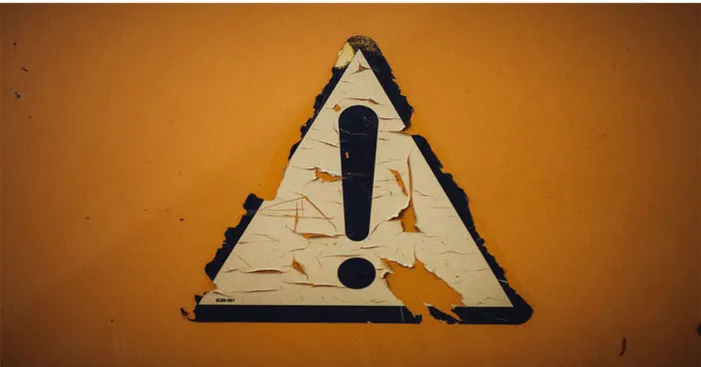
There is very little material when it comes to scientifically based proof of crab side effects.
Nonetheless, there are a few side effects that we can conclude and should be aware of including:
Affordability:
With more than 40$ per one Dungeness crab, this seafood delicacy is certainly not cheap. (8)
In fact, with that same amount you can buy 5 raw chickens or 8 lbs of beef and that is too expensive however, it is still a must-try product.
Difficult to consume:
Crab meat is very difficult to get when the crab is still unpeeled, which is one we certainly need to use splitting tools to help break the outer shell.
Not only do we need tools, but also we need to be careful with the amount of pressure we put in as we don’t want the shell to shatter and mix with the meat.
Nonetheless, this could be seen other way as most people find it enjoyable to sit down and crack the different parts of crab shell and be rewarded each time.
High cholesterol and sodium:
One serving of Dungeness crab is about 6oz (163g) and it contains about 50% and 20% of the daily needs respectively in cholesterol and sodium.
These amounts are not dangerous for most people, but certainly not safe for those who already have a high blood pressure or suffer from cardiovascular disease. (9)
Now that you learnt about the different nutritional data and crab health benefits, it is time to learn few more things about crab:
Crab taste:
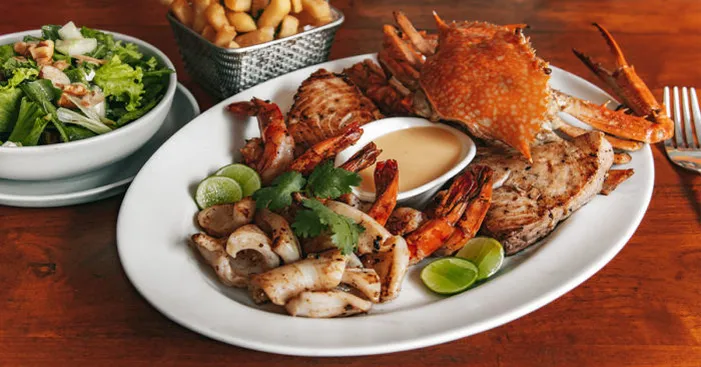
People who consume crab meat always say “once you taste crab you will never forget its taste”.
In fact, those who are addicted to seafood claim that crab meat is not inferior to lobster as it is a delicacy on its own if handled properly.
The meat of a crab is not only full of health benefits but is extra juicy and soft almost dissolves into the mouth when you eat it.
These characteristics remain the same even during the preservation process as you will always enjoy its juiciness when you cook it.
In addition, crab meat contains glycogen which is a special carbohydrate that gives the meat a touch of sweetness.
Getting crab health benefits while avoiding side effects:

Crab recipes:
Crab soup:
Ingredients:
- 6 ounces (165g) of Dungeness crab (1 crab).
- 2 cups milk.
- 2 cups cooking cream.
- 5 tbsp of butter.
- ½ cup of dried cherries.
- 1 tsp of salt and 1tsp ground black pepper.
Preparation:
- Start by melting the butter in a pan.
- When all the butter is melted, add the crab meat and milk and bring them to a boil.
- Turn the oven to low heat 160°F (70°C) and let them cook for 20 minutes.
- Remove the pan from the heat and add the dried cherries, salt, and pepper then mix the ingredients.
- This dish is for one person, you can double or triple the ingredients to make enough for more people, enjoy it!
Crabs with garlic and butter:
Ingredients:
- 2 crabs (12 ounces, 330g).
- 1 chopped garlic bulb.
- 3 chopped peppers.
- 3 tbsp of butter.
- 1 tbsp of olive oil.
- 1tsp of salt.
- ½ cup of water.
Preparation:
- Start by heating olive oil with butter in a pan.
- Add the chopped garlic and fry them until they turn golden.
- You can now add the chopped pepper and cook it for 20 seconds.
- Now it’s time to add the crab meat and salt then mix all the ingredients while cooking.
- Pour the water, cover the pan and let them cook for 7 minutes.
- Serve the dish and enjoy it with your loved ones.
Medicinal and cosmetic uses of crabs:
Chinese are the most consumers of crab consumption worldwide and it goes way back in time in their culture. (10)
In the land of Kung fu, it is believed that crab meat has many health benefits and people eat it to deal with cold, chest stiffness, and hangover.
This is probably because crab is among the foods that make us generate heat once we eat them therefore it’s a good ally during winter.
Crab shell is also a natural source of Chitosan, a certain type of sugar that has many health benefits for the body. (11)
chitosan is a converted form of chitin which is a biodegradable type of natural polymer that helps form insects and crustaceans shells.
This natural compound in crab is not only used for nutrition but also in cosmetics thanks to its antioxidants and anti-fungal properties.
Because of that, chitosan is among the ingredients of many body lotions and food supplements as it strengthens immunity, fights diseases, helps with cell regeneration, detoxifies alcohol … (12)
Up to 70% of crab body is made of shell and sadly most of the shells doesn’t make it to the recycling process and simply go to waste.
Crab chitin or chitosan has many health benefits as it is antimicrobial, activates the immune system and it can break down over time.
However, crab chitosan is most effective in reducing bad cholesterol in the blood the reason why it’s used in the drug industry to make medicines.
Tips for buying crab:
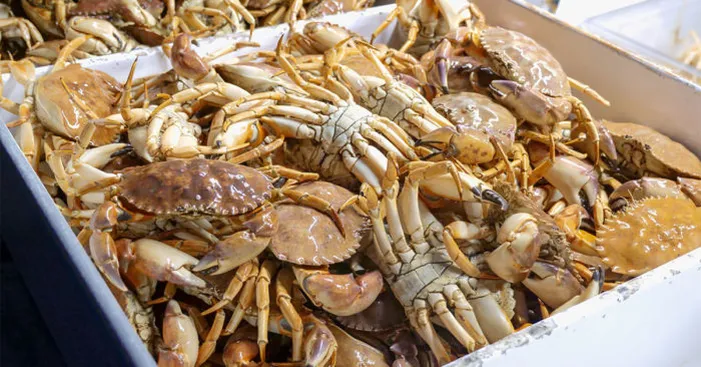
Crabs are part of the large family of decapods (have 10 legs) alongside shrimp and lobsters.
Thanks to their hard shell, its spider legs, and of course the “sidewalk”, crabs are famous around the world for their fine flesh, unlike any other meat.
Crabs, in general, exist in the market, live with their shells on (soft or hard), cooked or frozen.
Even though the price of an average crab sometimes surpasses $250, depending on the type, it is still worth every penny.
In fact, some types of crab can serve more than 10 people.
That means, if you have an average family you can use just 1 crab to make up to 3 meals.
However, it can be tricky to choose the best crabs in the market, so how to buy the best crabs?
Buying Crab:
Frozen crabs:
The crab season is very short as it only lasts for a couple of weeks.
It is because of that, most producers freeze it to ensure its availability throughout the year.
However, if you are buying frozen Crab there are a few things you need to know.
First, you need to avoid products with ice build-up as that means they have been frozen for too long. (13)
Second, crabs should not be discolored or show any signs of freezer burn.
Another thing you need to know is that frozen claws and legs tend to break easily so you should handle them carefully.
Cooked and live crabs:
First, to ensure the freshness of a crab, you need to know that its season is between October and January. (14)
This means the best time to buy crabs is at the end of fall and the beginning of winter.
Or you can just say from Halloween until Christmas.
However, if you are purchasing live crabs they should be active, so you need to poke its shell to ensure they react when touched.
On the other hand, cooked crabs must have a bright orange, moist shell with claws and legs intact.
Also, they should feel heavy in the hand as that means they were caught after their (15).
This is because crabs tend to have less meat if the molt is recent.
Another useful tip is to smell the crab and ensure it has a fresh oceanic smell with no ammonia smell. (16)
That would confirm the freshness since the ammonia smell is a sign of the decomposition of seafood.
Storing crab:

Hard-shelled crab:
For hard-shelled crabs, it is best to cook them as soon as you purchase them.
Then, you can put them in a sealed bag with ice, and store them in the refrigerator for up to 7 days.
In case you want to freeze them, cook them then place them in a bad alongside ice.
Frozen crab can be stored for months, but the sooner consumed the better.
Soft-shelled crab:
It is not recommended to freeze soft-shelled crabs as they spoil faster.
However, you can store them in a moist package in the refrigerator to consume within 3 to 5 days.
Conclusion:
To conclude, crab meat is one of the most complete sources of meat rich in protein, minerals, and vitamins.
The best thing is that you can get all of the crab health benefits without ruining your low-carb diet as crab meat is low in carbs.
If you are new to consuming crab meat, it may be difficult to start but you can use our easy-to-make recipe and enjoy all of the benefits of crab.
References:
(1): 6 of the Most Popular Types of Edible Crabs | Order Maine Lobster
(2): Nutrition Facts for Dungeness Crab (Raw) (myfooddata.com)
(3): Are Crab Legs Good For You? | Jimmy’s Seafood (jimmysobxbuffet.com)
(4): Facts about polyunsaturated fats: MedlinePlus Medical Encyclopedia
(5): [Iodine and thyroid gland with or without nuclear catastrophe] – PubMed (nih.gov)
(6): People who live within a mile of the coast are less likely to suffer from depression and anxiety | Daily Mail Online
(7): Seafood as Source of Protein‐based Functional Foods – Encyclopedia of Marine Biotechnology – Wiley Online Library
(8): Fresh Whole Cooked Dungeness Crab (Market Price) – Seattle Fish Company
(9): Can Diabetics Eat Crabs – TheDiabetesCouncil.com
(10): The Frozen Crab and Crab Meat Market Survives Pandemic Losses, With E-Commerce Promising a Recovery – Global Trade Magazine
(11): Chitosan extracted from mud crab (Scylla olivicea) shells: physicochemical and antioxidant properties – PMC (nih.gov)
(12): Chitosan for cosmetics and cosmeceuticals (primex.is)
(13): Frozen seafood quality (fishfiles.com.au)
(14): All About Dungeness Crab (kingsseafood.com)
(15): Crabs and Molting Process – Shrimp and Snail Breeder (aquariumbreeder.com)
(16): Crabs Smell Like Ammonia: What Should You Do? – Crabbing Hub
